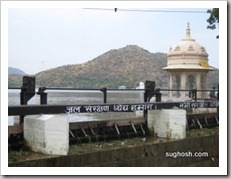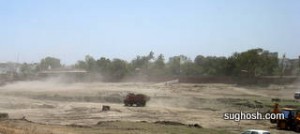 उदयपुर शहर, जो अपने प्राकृतिक सौंदर्य, झीलों, बाग-बगीचों, शौर्यपूर्ण इतिहास और सौहार्दपूर्ण वातावरण के लिये विश्व प्रसिद्ध है, अनियोजित विकास की ऑंधी में अपनी यह पहचान खोता जा रहा है। वास्तविकता यह है कि जो पर्यटक आते हैं वे यहॉं के नैसर्गिक सौंदर्य और यहॉं की स्थानीय शैली में निर्मित पुराने भवन, झरोखे, गोखड़े आदि देखने में रुचि रखते हैं न कि नव निर्मित कॉम्प्लेक्सों या बंगलों को। अगर विकास की आँधी में हम अपना अतीत नहीं संभाल पाए तो यहॉं का आकर्षण ही समाप्त हो जायगा।
उदयपुर शहर, जो अपने प्राकृतिक सौंदर्य, झीलों, बाग-बगीचों, शौर्यपूर्ण इतिहास और सौहार्दपूर्ण वातावरण के लिये विश्व प्रसिद्ध है, अनियोजित विकास की ऑंधी में अपनी यह पहचान खोता जा रहा है। वास्तविकता यह है कि जो पर्यटक आते हैं वे यहॉं के नैसर्गिक सौंदर्य और यहॉं की स्थानीय शैली में निर्मित पुराने भवन, झरोखे, गोखड़े आदि देखने में रुचि रखते हैं न कि नव निर्मित कॉम्प्लेक्सों या बंगलों को। अगर विकास की आँधी में हम अपना अतीत नहीं संभाल पाए तो यहॉं का आकर्षण ही समाप्त हो जायगा।
-
Recent Posts
Recent Comments
- Suresh on उदयपुर का जल प्रबंधन – अतीत और आज
- gpsoni on Say No to R.O. Filters and Bottled Water
- Sushil Vashishth on Say No to R.O. Filters and Bottled Water
- Nazrul haque on सीएफ़एल (CFL) बल्ब और ट्यूब – सोच कर लगाएँ और खतरों से रहें सावधान
- sumama on Environment Friendly Technology for Waste Water Treatment
Archives
- September 2021
- September 2016
- April 2016
- June 2014
- April 2014
- February 2014
- December 2013
- November 2013
- August 2013
- July 2013
- June 2013
- May 2013
- February 2013
- December 2012
- October 2012
- September 2012
- August 2012
- July 2012
- June 2012
- May 2012
- March 2012
- February 2012
- December 2011
- November 2011
- October 2011
Categories
- ENGLISH SECTION (अंग्रेज़ी प्रभाग)
- Environment
- Health Tips
- Home Tips
- Our Rajasthan
- Our UDAIPUR
- Technical Articles
- Uncategorized
- UNCLASSIFIED – अवर्गीकृत
- Water Management
- अपना उदयपुर
- अपना राजस्थान
- कतरनों की कतरन
- घरेलू नुस्के
- जल प्रबंधन
- जल बचत
- जल संरक्षण
- जीवन परिचय
- नगरीय विकास
- न्याय व्यवस्था
- पर्यावरण
- पानी से संबंधित मुख्य इकाइयां
- प्रेरणा के स्त्रोत
- मेवाड़ी प्रभाग (MEWARI SECTION)
- विकास योजनाएं
- विविध
- संपन्नता
- स्वास्थ्य
- हिंदी गरिमा
- हिंदी प्रभाग (Hindi Section)
Meta
Categories
Tags
- 2012
- artificial lighting
- artificial recharge
- asthma
- barefoot
- cancer
- CFL
- claims
- Conservation of lakes
- conservation of water
- depression
- drinking water
- high blood pressure
- Lake conservation
- Udaipur
- water management
- उदयपुर
- एम. विश्वैस्वरैया
- गरीबी
- जन समस्या
- जल
- जल प्रबंधन
- जल बचत
- जल संरक्षण
- दुबई
- नगर नियोजन
- पर्यावरण
- पर्यावरण संरक्षण
- पाणी
- पुन:च्रक्रण
- भारत रत्न
- भोजन
- मेवाड़
- मेवाड़ी
- मोक्षगुंडम विश्वैश्वरैया
- राजस्थान
- रोज़गार
- वर्षा
- वाटर हारवेस्टिंग
- विकास कार्य
- विरासत
- हरित क्षेत्र
- हिंदी गरिमा
- हिंदी भाषा
- हृदयरोग







 In modern electrical wiring of a home or office, providing M.C.B.s at various points of distribution is very common. This facility is very useful in case of overload or short circuit and saves the wiring from damages but it consumes power constantly just to be ready for automatic shutoff of power and therefore needs careful consideration before installation in view of the need for saving electricity.
In modern electrical wiring of a home or office, providing M.C.B.s at various points of distribution is very common. This facility is very useful in case of overload or short circuit and saves the wiring from damages but it consumes power constantly just to be ready for automatic shutoff of power and therefore needs careful consideration before installation in view of the need for saving electricity.